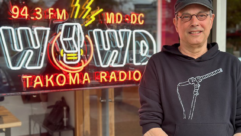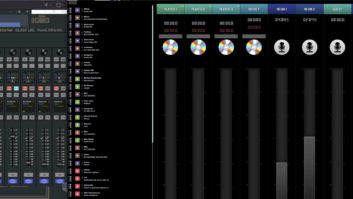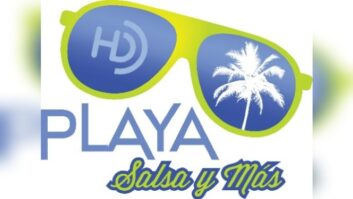
One FM radio announcers William and Jess hosting a client sponsored OB. We used AoIP to send onsite audio back to the studio for live broadcast.
PETALING JAYA, Malaysia — AoIP is rapidly expanding in the broadcast world, particularly now that the technology has matured. Here at Media Prima Radio Networks, we’re moving forward with the times by utilizing AoIP for our outside broadcast productions and to distribute our central studio feed to our two regional studios. We tried and tested several products for about a year before optimizing our design and configuration based on real life stress tests and field deployments.
Usage in OB production
For OBs, we either use a 3G mobile connection or a DSL broadband connection to send our site audio feed back to the studio for on air broadcast.
We are currently using a Prodys Nomada IP XL with a 3G USB dongle or a DSL broadband connection at the onsite setup. Some of the reasons why we chose the Nomada were its portability, battery life, a built in audio mixer, and the ability to utilize ISDN on the rare occasions that we still need to. (ISDN is being phased out and we find that most new townships do not carry the service). During our testing, the Nomada came up tops for stability.
The Nomada connects back to a rackmounted Prodys Prontonet codec at the studio, which has a dedicated DSL broadband connection with a static IP address.

The Nomada web interface allows us to adjust the encoding compression settings.
Both connection methods use AoIP but here are some issues to take into consideration when deciding to go with 3G or a DSL broadband connection.
Comparison3GDSLMobilityVery portable. You can even use it while in a moving vehicle with a battery equipped Nomada.Similar to ISDN connections, you will need a service provider and a contractor to install a fixed line at the OB location, this incurs costing on top of the usage charges.Stability
Subject to mobile network coverage and cell capacity — not advisable if there are large crowds.
3G connections can be shaky and will cause breaks in sending/receiving audio. If the situation is bad, we tend to pre-record our talksets when there is a good connection.
A site reccee with the codec itself is important. We recommend going to the location and sending/receiving audio to the studio with the Nomada for a good 20 to 30 minutes prior to the actual OB.
Stability is usually top notch, so no worries about audio drops, as long as the cable is securely installed and there is no service interruption.
Service provider and cost
We recommend having at least two different mobile network SIM cards with unlimited data usage to swap if necessary. Network coverage may differ according to provider and area.
The cost for 3G is really low if you have an unlimited data plan (usually a flat rate).
A single service provider is sufficient, who will probably bill you based on usage duration and data transferred.
The cost is considerably higher compared to 3G.
Recommended audio compression and bitrate
MPEG 4 AAC LC Stereo 64 kbps 48 KHz
Suitable for sending voice, but not recommended for music.
In our experience, a 3G connection cannot hold a higher bitrate than 64 kbps in real life conditions.
MPEG 4 AAC LC Stereo 192 kbps to 256 kbps 48KHz
This is based on a 1 Mbps ADSL connection.
Audio compression bitrate can be increased if there is a good broadband connection — this should provide “CD quality” audio suitable for voice and music.
Some general usage tips:
•We recommend setting the studio unit codec to an auto encoder/decoder configuration so that the audio compression can be decided by the OB site codec. The site codec will most likely have to vary its compression according to its connection speed and quality. When the connection is strong, switch to a higher bitrate for better quality, and likewise reduce bitrate if bandwidth is an issue. The switch shouldn’t take longer than 10 seconds.
•Be sure to fully exploit the AAC algorithms available on most codecs these days. This will provide quality audio at low bitrates.
•Having a dedicated fixed line broadband connection at the studio with a static IP address is a must. We don’t recommend a 3G to 3G connection. The static IP address is so that the portable unit can “find” the studio codec with ease, and we have programmed all our studio IP addresses into the unit’s phonebook. We use a SDSL connection that offers a stable 2 Mbps upstream/downstream to send and receive audio. Having a “firm” and stable studio setup leaves any required troubleshooting at the OB site, which is most likely where you’ll face challenges.

Compared to ISDN, some IP configuration will be required on the codec. This information is usually available from the service provider.
•When choosing a broadband connection the upload speed is important for sending audio, and the download speed is important for receiving audio. Choosing a SDSL connection provides symmetrical download and upload speed, as compared to ADSL, which focuses more on download speed. When possible we go with an SDSL connection as we send and receive equal amount of audio.
•Most Internet service provider packages are “best effort” speeds, which means the connection speed will vary according to a number of factors. It’s best to benchmark that you will roughly achieve 70 percent to 75 percent of the offered speed on a DSL connection.
•The only drawback about using AoIP is eventual audio delay (up to 0.5 to 1 second) depending on network conditions. This may take some getting used to for those who are used to ISDN’s low latency.
AoIP for feed distribution to regional studios
Earlier this year one of our stations, Hot FM, launched two regional studios in the East Coast of peninsular Malaysia broadcasting localized content and spots at specific hours in two states. For the rest of the day, the station rebroadcast the national feed.
Initially we deployed an ISDN setup to distribute our central studio feed to the regional studios for the rebroadcast. This required two pairs of ISDN codecs and we ranked up a heavy usage bill for the outstation call charges. We considered installing a leased line connection but were discouraged by the hefty charges and the long-term service commitment.
After some evaluation, we decided to install three units of the Prodys Prontonet LC codec.

Simon Lee
The first one was mounted at the central studio and was set to a multi unicast configuration. This is connected to a high-speed broadband connection (fiber to the home) — we required a large bandwidth connection as this unit is pushing audio to two sites, which effectively means two connections running 24 hours. This codec serves as the encoder with the central studio program feed as its input.
At each regional studio they have a similar Prontonet LC unit to receive and decode the feed over a DSL broadband connection.
All Internet connections here have static IP addresses so that all three codecs can “dial” each other easily and so that we can monitor the performance of all our codecs and network conditions using the built in remote monitoring Web interface provided.
We also recommend direct and dedicated Internet connections for all the codecs — which means no sharing with other services or devices. If a firewall is used, be sure to open the relevant ports for audio transport and for the web interface. This information is available from the product’s manual and can be altered accordingly.
We are using MPEG-4 AAC LC Stereo 128 kbps as the compression with sampling frequency of 48 kHz.
Now with one codec at the central studio we are able to use AoIP to distribute CD quality audio to both the regional studios. With the built in error correction provided by the codecs and a stabile Internet connection, we barely experience any audio drops.
It is important to note the cost savings here — on top of the capital expenditure for the three codecs, our monthly recurring costs are just for the three Internet connections and these are all flat rate plans with unlimited data transfer usage. We leave the connections running 24 hours, seven days a week.
In the rare event that this AoIP setup fails, we switch to ISDN by switching the interface on the same codecs.
Summary
Overall the design and configuration of our system has served us well. The results are derived from much discussion and trials with our network service providers and vendors.
At some point, I think all broadcasters will implement some sort of AoIP installation and will recognize the cost benefits. Evaluate and try out different products and connection methods to see what best suits your requirements.
Technical teams just need to have some basic knowledge of IP protocol configurations and different compression bitrates and algorithms. We are now looking at utilizing more AoIP within the studio too.
Simon Lee is assistant manager, engineering at Media Prima Radio Networks in Malaysia, comprising Hot FM, Fly FM and One FM. He can be reached at [email protected].
The author would also like to give credit to the rest of the engineering team at MPRN: The Head of Engineering Akhmal Andak, and engineers Firdaus Shamsuddin, Simon Warkey, Ivan Loh, Faizal Yaacob, Hasrul Ariff, and Muhammad Rohizzi.











